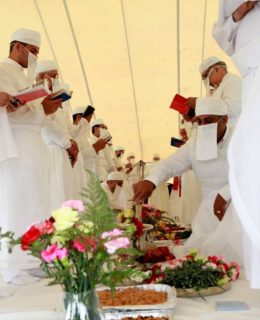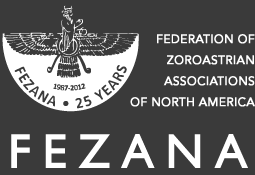
By Daryoush Jahanian, M.D.*
(This article is dedicated to the memory of Dr. Ali A. Jafarey)
[This article originally appeared in the FEZANA Journal, Volume 35, No. 1, Spring 2021; pages 60-63, as part of that issue’s theme topic, “Zarathusthra’s Gathas in the Contemporary World”. Reprinted here with permission from the author and from the FEZANA Journal Editor-in-Chief. FEZANA Journal is available as Digital-only or print versions. See FEZANA Journal webpage for more details]
I have studied various translations of the Gathas in English and Persian, I have taught them in religious classes. Throughout my dedicated study, I have always struggled with one mind-boggling issue. The thoughts and concepts reflected in the Gathas were far beyond the farming and herding society of their era. How could these advanced notions develop during that time period? I noticed that, from the beginning, various translators of the Gathas have similarly struggled with this contrast. Earlier, some of them tried to adjust their translations to the environment and time. These translations contained a lot of issues regarding pasturelands and domestic animals. But these translations still did not answer the question of how, in that society and time, the advanced concepts of liberty and freedom of choice could develop. Then, some scholars took a more drastic approach by trying to move the date of the Gathas forward all the way to 100 A.D.1
Others presented another theory that the Gathas were a production of a group of thinkers who addressed an imaginary saint, named Zarathushtra.2 They refer to the Gathas’ verses in which Zarathushtra is addressed in the third person. These scholars however are not familiar with Persian poetry, in which, to this day, Iranian poets name themselves in their poems and address themselves in the second or third person. In addition, they ignore a number of aspects of the Gathas. First, Zarathushtra repeats the following phrase several times in the Gathas: “I am Zarathushtra, the strong supporter of Truth and true opponent of Falsehood, and as long as I have strength and will-power, I teach the people to strive for Truth.” Second, in Yasna 30, 45 and 53, Zarathushtra addresses the audience in the first person, and in Yasna 28 he declares his mission, to bring happiness to both the material and the spiritual worlds. I persuaded myself by believing that according to Yasna 29-11, there was an association of scholars, Magavan, who after comprehension and analysis of the teachings, would spread the message to ordinary people. But today I am not so confident, because some of the Gathas’ concepts even in our time require careful explanations to be understood by the public. They include but are not limited to the Divine attributes and mental faculties of mind, wisdom, conscience, will-power, soul, and adding to them, Spenta Mainyu or creativity.
AHURA MAZDA
Zarathushtra is concise and precise, and the Gathas in their totality consist of 238 stanzas. Hence, careful analysis of each sentence of the Gathas is required to extract Zarathushtra’s advanced thoughts. For example, in Yasna 31.8, Zarathushtra defines Ahura Mazda as both the oldest and the youngest entity. The free renderings generally have been: Ahura Mazda is the beginning and the end. But I believe here, Zarathushtra defines the real nature of God by amazingly careful selection of the words: Ahura Mazda as an entity has no birth (the oldest, or by Zarathushtra’s words the most ancient), and no death (the youngest). In simple words, God is beginning-less, or always has existed, and endless, or always shall exist. In Pahlavi: Abada, Abi-anjam. Careful analysis of the Gathas reveals more progressive concepts that apply to modern times.
SEPARATION OF CHURCH AND STATE
In the entire Gathas, Zarathushtra refers to the regional rulers (Kavis) and the religious leaders (Karapans), who have unified forces and exploited hardworking people by coercion. He stands against both. In Yasna 32.14 he addresses Grahma : “For a long time Grahma (a spiritual leader) and the Kavis are using their minds and power to hurt the faithful. They wish death and destruction to the world, fired by the wisdom-wasting drink (Haoma juice) and hoping that the invincible (Haoma) will protect him.” ” But the power that Grahma has attained by conspiracy and bad deeds will finally destroy him Y 32.13.” Here, Zarathushtra is delivering his message to the corrupt rulers: The power that you have attained through force and corruption will destroy you and you will become the victims of your own corrupt power.
Today it is generally accepted that the two holy prayers, Ashem Vohu and Yata Ahu, were composed by Zarathushtra. Yata Ahu is about establishing the ideal “Chosen Dominion.” Let us analyze: Yata Ahu vairyo, just as the worldly leader (Ahu) is to be chosen; ata Ratush, so is the spiritual leader (Ratu); ashat-chit hacha, for their righteousness…We can extract from this first sentence that the spiritual leader’s (Ratu’s) position is separated from that of the material leader (Ahu), at the same time both are chosen for their righteousness… Zarathushtra had observed the harms resulting from the unification of state and religion (Kavis and Karapans). By teaching the separation of these two chosen (elected) officials, does Zarathusthra not preach separation of church and state, a foundation of modern democracy?
CAMPAIGN FOR JUST RULE
The teachings of Zarathushtra in the Gathas maintain that determination of destiny is an individual responsibility through wisdom and freedom of choice. Accordingly, every individual is the author of his/her own life, and no one is condemned by pre-ordained fate. These teachings leave no room for slavery, a concept that unfortunately exists in the writings of many religions. The message of Zarathushtra is a warning to those who rule through oppression, exploitation or enslavement: He proclaims, in Yasna 32.15: “Finally the oppressed shall rise up and defeat those who have deprived them of freedom, and the liberated people with two gifts of wholeness and immortality shall enjoy freedom in the abode of good mind (real paradise).”
It is noteworthy that, in this verse and Yasna 31.18, which recommends active resistance toward those who resort to violence, Zarathushtra carefully shuns references to bloodshed. In Yasna 31.18, he uses word Sazdum, which means to correct and teach the aggressor, while he avoids the word Merezdum, which means killing and wounding.
In general, Zarathushtra wishes for all men and women to participate by their own will in an active movement to establish the chosen dominion. But his voice through the darkest period of history is heard: “Withhold your anger. Keep hatred far away, do not resort to violence, and hold on to love and the good mind” Yasna 48.4. ” Peace shall overcome violence and through good rule humanity enjoys peace and prosperity. Stand firm against the cruel tyrants with the wisdom of good mind. “Yasna 48.11. Here Zarathushtra is teaching, in a campaign against the tyrants, to use wisdom, hold on to the good mind, and avoid anger and violence so that in the end good rule prevails. Otherwise by resorting to violence a new tyranny will replace the old one. Isn’t Zarathushtra teaching the present nations that in your struggle for a just government, anger and violence can be counter-productive, because they can result in a new tyranny? and by holding on to good mind and wisdom, you can finally achieve the desired good rule?
GENDER EQUALITY AND THE FAMILY UNIT
Zarathushtra addresses all humans equally regardless of gender, race or nationality. Of interest in the Gathas gender is not an issue because men and women are addressed equally, and even in some verses women are mentioned first. Yasna 53.5, 53.8. This is truly outstanding because in so many teachings, women do not enjoy equal standing to the men. One should be reminded that in the U.S., women did not have the right to vote until 1920, and in Switzerland, women’s electoral rights were finally established in 1971. Even today, women are not equal to men under the constitutional laws of many nations.
In Yasna 46.10, Zarathushtra enunciates that women and men equally receive salvation by good deeds: “The man or woman who performs the work declared as the best by You in this world, a life full of truth and spiritual strength achieved by good mind and service to humanity, I shall teach them to worship You alone and shall guide them to cross the sorting bridge.” In Yasna 51.22, the Wise God recognizes men and women for their good deeds and worship. This is the predecessor of the holy prayer, Yenghe Hatam, in which men and women are praised for their acts of worship through conduct of good deeds.
In Yasna 53, or the chapter regarding the wedding, Zarathushtra expresses his wish, a good husband for his youngest daughter. He is to be righteous, wise and who has attained the divine attributes, but she is left free to decide. We do not see such freedom and respect of women in the Greek and Roman civilizations that millennia later were developed in Europe. Of particular interest is the advice of Zarathushtra to the newly-wed couples. First, as a show of respect he mentions brides and then bridegrooms. Second, rather than dictating dominant and subservient roles, he encourages the bride and groom to “try to surpass each other through righteousness.”3 Finally, Zarathushtra teaches that family life is based on monogamy, as he states: “Disassociate yourself from temptation and lies, and remember that the joy and satisfaction that is linked with dishonor shall bring sorrow and bad reputation…” Isn’t Zarathushtra talking about the importance of the family unit and family life in our modern world?
HUMAN RIGHTS
Human rights is a modern term coined only forty years ago. But the concept is not new to those of us familiar with the teachings of Zarathushtra, because 3800 years earlier, he presented human rights in a very comprehensive manner under “Freedom of Choice.” In the Gathas, freedom of choice covers all aspects of human rights, beginning with the right to accept or not to accept the words of Zarathushtra, the freedom to choose one’s path of life, and to determine one’s destiny. Yasna 30.2. There is more emphasis on freedom of religion, when he announces that men and women are granted life, conception, intellect, will-power with deeds and doctrine so that they can choose their religion and beliefs freely. Yasna 31.11. Hence, coercive conversion is not permissible. Then he presents another novel concept for all ages, freedom of expression: “Every person, whether right or wrong, wise or unwise, should announce his/her belief freely and express what is in his/her heart and mind…” Yasna 31.12.
People are given the freedom to choose their leader by wisdom in full serenity, because this is an emotional decision. Meanwhile they are warned against wolves disguised as lambs. As Zarathushtra puts it: “Never may a false leader with a sharp memory who pretends piety rule.” Yasna 31.9,10. It is of noteworthy that in three emotional states, Zarathushtra recommends that people should decide by wisdom and in full serenity, choice of path and destiny, Yasna 30, choice of leader, Yasna 31, and choice of spouse, Yasna 53. In those occasions, remaining emotional can result in the wrong decision. Zarathushtra calls the ideal government, the Chosen Dominion or Khshathra Vairia, because it is to be chosen by men and women in search of freedom and justice. Even participation in this movement is by free-will.
In Yasna 53.3, freedom of choice extends to the choice of spouse, when Zarathushtra advises his daughter to choose her husband with full freedom. Finally, respect for human dignity is so paramount that even God is not imposed upon man, but rather humans will choose God by conduct of good deed. In Yasna 53.2, Zarathushtra declares: “So, let all strive with thought, word and deed to satisfy Mazda. Let each one choose to perform good deeds as His true worship.” The best gifts dedicated to God are the fruits of good thought, good word and good deed with love, Yasna 33.14, 34.1, and no rituals and blood sacrifices are recommended. These sublime teachings of 3800 years ago, which cover the individual and social rights of all human beings regardless of gender, race and nationality, can be considered a miracle in the history of religion.
JUSTICE AS THE FOUNDATION OF CIVILIZED SOCIETY
Zarathushtra teaches that the reward of justice is peace. Yasna 33.1 illustrates the importance of law and duties of the supreme judge: “According to the Primal Laws of Life, the just leader should do full justice to the wrongful and to the righteous, as well as to the person whose falsity and probity are combined.” In Yasna 31.13 he says, “Mazda is well aware of the thoughts and deeds of everyone in open and in secret, and why sometimes a person for a small sin pays a heavy price.” Yasna 31.14 reads, “The Wise God is well aware of the past and future, what is the reward of the righteous and the punishment for the wrongful and what is their standing when their action is complete.”
Finally, Mazda with His creative mind (Spenta Mainyu), and by the means of His light of wisdom empowered by truth and justice (Asha), will determine the reward and penalty for the two groups. Yasna 47.6. It is significant that upon reckoning, all stand equal before the law and the men of power, for their wrong deeds, will pay the price on the bridge of judgment as well. Yasna 46.11. Finally, Zarathushtra declares: “Once the principles of happiness and pain ordained by Ahura Mazda are realized, that the wrongful will suffer for a long time and the righteous shall enjoy everlasting happiness and prosperity, then all should receive salvation through right choice.” Yasna 30.11.
CONCLUSION
Zarathushtra’s peaceful campaign for improvement of the living world was twofold: religious and social. As he declared in Yasna 28.2, his goal was to bring happiness and prosperity to both spiritual and material worlds.
It is generally believed that the renaissance was a European phenomenon of the middle ages. But in the Gathas, Zarathushtra teaches that notion not only through his visionary and novel ideas of world views and the perfect human society, but also when he proclaims: Let us renovate the living world; Yasna 30.9, let us refresh this life.” Yasna 34.14, 50.11.
<><><><><><>
Endnotes
*Many thanks to my son Arash Jahanian for editing this article.
1 James Darmesteter: quoted from Zartusht, Mazdayasna and governance, J.Ashtiyani, in Persian, 1984,p64
2Jean Kellens of Sorbonne, believes the Gathas is not the creation of a single known author, quoted from the website on Zarathushtra and Zoroastrianism, The problem of legend versus fact.
3Dina McIntyre, CZC zoom seminar on women in the Gathas.
Dr. Daryousdh Jahanian, M.D. was a Founder and the First President of the Fravarhar Zoroastrian Youth Organization, Tehran, and also Founder and First President of the Zoroastrian Association of Kansas (ZAKA). He has served as a trustee of the Guiv Trust and then Trustee of the Trust of Rustam Guiv Foundation.
Two books written by Dr. Jahanian are: The Zoroastrian Doctrine and Biblical Connections; and, Gathas, The Message of Zarathushtra with free translation and comments.




